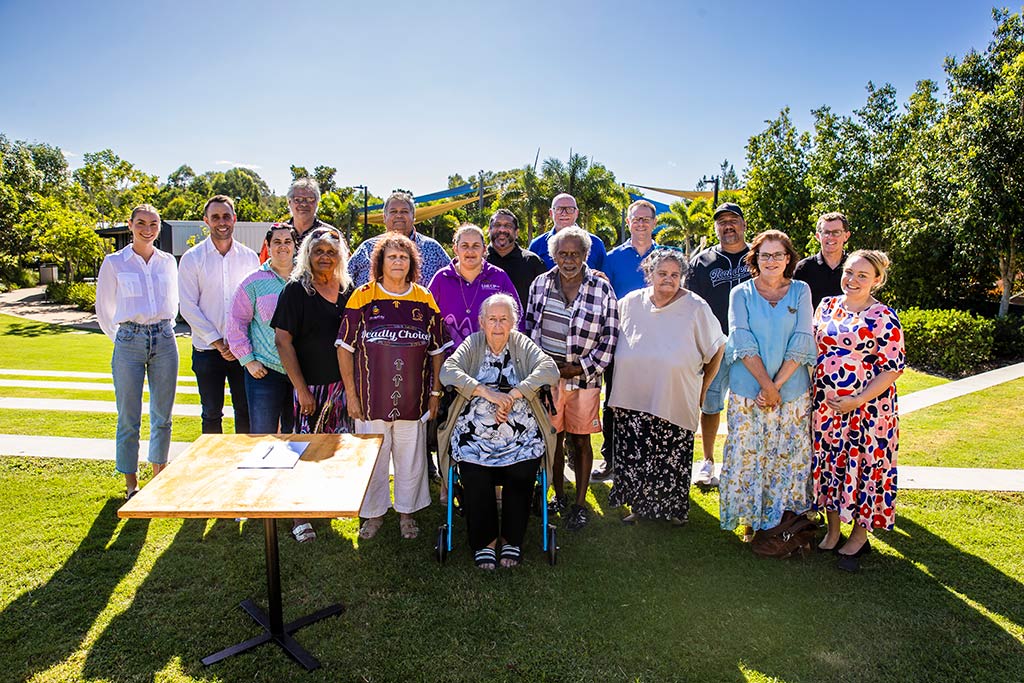OUR DEEP CONNECTION TO COUNTRY
CAN BE SHARED THROUGH A PROCESS OF
TRUTH-TELLING AND HISTORICAL ACCEPTANCE.
OUR DEEP CONNECTION TO COUNTRY CAN BE SHARED THROUGH A PROCESS OF TRUTH-TELLING AND HISTORICAL ACCEPTANCE.

DEEBING CREEK MISSION AND ITS LEGACY

The Deebing Creek and Purga Missions are central to the Ipswich region’s First Nations history and to the YUP native title claim area. Our ancestors were born on the Deebing Creek mission and were local to the area before that.
We respectfully acknowledge that many people feel a strong connection with Deebing Creek and Purga through family connections to the missions.
As the recognised custodians of the land and waters, here we share some stories and history of the region to help build understanding and acceptance. The future cultural centre will provide opportunities for more stories to be shared.


It’s important we teach the little fellas about the old days of growing up on Country. The cultural precinct will help with that – it’ll be somewhere to keep our stories, our artefacts. And it’ll be for everyone.
– Faye Carr (Elder)

It’s important we teach the little fellas about the old days of growing up on Country. The cultural precinct will help with that – it’ll be somewhere to keep our stories, our artefacts. And it’ll be for everyone.
– Faye Carr (Elder)
PAST, PRESENT AND FUTURE

Today, the Yuggera and Ugarapul peoples are recognised as the native title claimants of the region including Deebing Creek.
In 2017, with increasing development in the region, we filed a native title claim that was accepted by the National Native Title Tribunal.
First Nations people have been connected to Country in the Ipswich area for thousands of years – long before European settlement. Settlement caused massive upheaval. Across Queensland and New South Wales Indigenous people were culturally dispossessed. In many cases they were forcibly relocated from their traditional lands to colonial missions and reserves. Some of these were set up in the Ipswich region including Deebing Creek and Purga Missions.
Below is a timeline that shares some key dates and information about the history of the YUP and Deebing Creek Mission.
Source 1847-1948 information : Habermann, Daniel. Deebing Creek & Purga Missions History Book. Published by Ipswich City Council, 2003. Publication accessed November 2023 via https://www.pictureipswich.com.au/
KEY DATES AND INFORMATION

1827-1880s
EUROPEAN SETTLEMENT IN THE AREA

View of Ipswich in 1887 (photographic image). Dewhurst, A. Item held by John Oxley Library, State Library of Queensland. Public Domain.
In 1827 convicts and an overseer were sent to set up Limestone Station, a quarry to support the manufacture of mortar for building construction in Brisbane. In 1842, the Ipswich area was opened for free settlement. Violent interactions took place between new settlers and the local Aborigines (Red Gum, The Queensland Times, 18 July 1892). The free settlement era led to Aboriginal people being culturally dispossessed, devastated and experiencing population decline.
In the 1880s a group of businessmen and women set up the Aboriginal Protection Society. The group was concerned for the wellbeing of local Aborigines who by this time were mostly camped at Queens Park and struggling under white cultural influences – particularly alcohol. In 1889 the Society was taken over by members of local church groups who acquired land (with the Government’s assistance) to set up a safe place for the struggling Aborigines, away from central Ipswich.
1892
DEEBING CREEK MISSION ESTABLISHED, 1892

1903 postcard showing Deebing Creek Mission, residents and their cottages. Initially the reserve contained bark huts, later replaced by tents, then cottages post-1900, as shown here. Source: accessed 21 February 2024 via www.trove.nla.gov.au/work/2231576630. Item in the public domain.
In March 1892, Reverend E. Fuller, a former British soldier, “induced several of the Queens Park campers to go out with him and settle on the land at Deebing Creek” (‘The Austral Star’, a Presbyterian Journal, 1 October 1907).
The mission aimed to provide a safe home for scattered remnants of local tribes. Following the initial move the arrangements of the Aboriginal home were formalised and a Reverend Robinson was appointed as the home’s President. Over the years, the Deebing Creek Mission built superintendent’s quarters and slab huts/humpies (later replaced with cottages), planted crops (although soil quality was poor and water limited), and erected a school building.
1892-1914
DEEBING CREEK MISSION EVOLVES

Deebing Creek School Children (undated photographic image). Source: Habermann, Daniel. Deebing Creek & Purga Missions History Book, p17. Published by Ipswich City Council, 2003. Original image source unclear. Publication accessed November 2023 via https://www.pictureipswich.com.au/
In 1896 the school had been proclaimed an industrial school under the Industrial Schools and Reformatories Act of 1865. As a result many children in poor condition from all over Queensland were being sent to Deebing Creek. By 1897, the mission’s population had fluctuated between 100-170.
In 1898 the Aboriginal’s Protection Act came into force imposing controls over Aboriginal people removing their fundamental rights to autonomy and choice. A “Protector” of Aborigines could now determine where a person was to live and be employed, who people could marry (interracial relations at this time were highly taboo), and more. Children could be taken from their parents, put in dormitories and sent out to compulsory work. Aboriginal people could be forcibly removed from their homelands to reserves and were subjected to imprisonment if they left without permission. Over time, this resulted in people being sent great distances to Deebing Creek Mission.
By 1910 all youngsters from the mission had been placed into employment while adults continued to do compulsory work on the mission. In 1912 the government withdrew funding on the basis that school numbers had dwindled to less than ten. The Committee decided to move the main mission from Deebing Creek to Purga, where there was better soil and access to creek water.
1914-1948
DEEBING CREEK RELOCATES TO PURGA MISSION

Davidson family and members of the Salvation Army (photographic image). Source: Habermann, Daniel. Deebing Creek & Purga Missions History Book, p44. Published by Ipswich City Council, 2003. Original image source unclear. Publication accessed November 2023 via https://www.pictureipswich.com.au/
In 1914 a new Purga homestead and cottages were constructed. Approximately 85 people from Deebing Creek took up residence. Following the move there was a lengthy drought so the Purga mission scraped by until the Salvation Army stepped in to assist from around 1920 onwards. By the time of WWII 1939 – 1945 the mission was on its way out and it closed in 1948. The land was transferred to the government and sold off without consultation to the original workers or their descendants.
2017
YUP BECOME RECOGNISED NATIVE TITLE CLAIMANTS

The National Native Title Tribunal recognised the YUP Claim
On 7 April 2017, a native title claim was filed in the Federal Court of Australia on behalf of the Yuggera Ugarapul People.
On 4 August 2017, the QUD213/2017 YUP Claim was accepted for registration by the NNTT and has remained on the Register of Native Title Claims since then.
2023
YUP SIGNED MOU FOR CULTURAL PRECINCT

The signing of the agreement to build a cultural precinct
On 24 March 2023, the YUP signed a ‘Memorandum of Understanding’ (MOU) with Stockland, AV Jennings and Moremac to begin planning a cultural precinct to be built on the Deebing Creek Heritage site, nine kilometres south of the Ipswich CBD.
Developers Stockland, Moremac and AVJennings have committed to supporting the building of a new cultural precinct. The MOU outlines the collaboration between all parties. The YUP will play a leading role in the design of the Deebing Creek Heritage Site Cultural Precinct.

HERITAGE CITATION
Deebing Creek Mission is listed on the state government’s Queensland Heritage Register. Listed places contain ‘heritage citations’ prepared by heritage professionals and that note relevant information about a place, including details of significance, historical context, physical characteristics (including landscape and built structure elements, etc). Heritage citations aim to support the appropriate future management local heritage places ensuring an accessible understanding of their significance. The Deebing Creek Mission (former) heritage citation acknowledges that it was a mission / reserve and burial ground / cemetery for Aboriginal people – sites considered of “great significance” to the traditional Aboriginal people of the area and those that were relocated to the area when the mission was active.


YUGGERA AND UGARAPUL PEOPLE (YUP) STORIES








